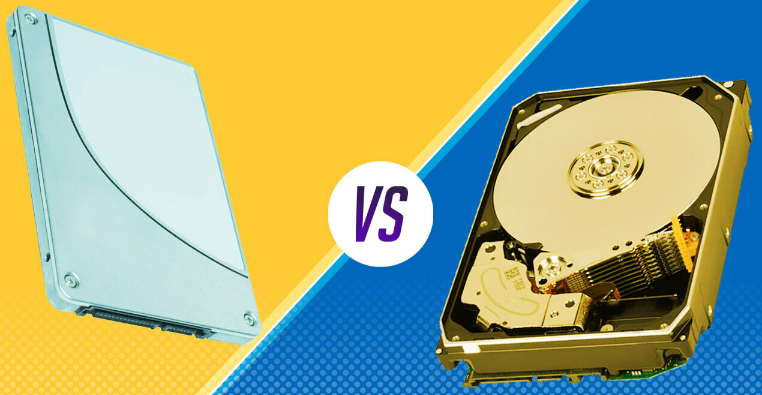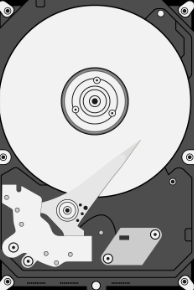Table of Contents
Hard Disk Drive vs. Solid State Drive
In the realm of data storage, the advent of solid-state drives (SSDs) has revolutionized the way we store and access information. These powerful storage devices have challenged the dominance of traditional hard disk drives (HDDs) with their exceptional speed and efficiency.
In this article, we will delve into the key differences between HDDs and SSDs, exploring their respective advantages and disadvantages, to help you make an informed decision when it comes to choosing the right storage technology for your needs.
What is Hard Disk Drive?
HDD stands for “hard disk drive.” It is a traditional storage device that has been widely used for many years. An HDD consists of one or more rotating magnetic disks, or platters, coated with a magnetic material.
HDDs store data by magnetizing tiny areas on the platters, representing the binary digits (0s and 1s) of digital information. The read/write heads are responsible for reading the magnetic patterns on the platters to retrieve data or writing new data by modifying the magnetic field. The movement of the heads and the rotation of the platters introduce mechanical latency, resulting in access times that are relatively slower compared to solid-state drives (SSDs).
HDDs have been popular due to their large storage capacities, affordability, and compatibility with a wide range of devices. They are commonly used in desktop computers, laptops, servers, gaming consoles, and external storage devices.
- HDDs consist of one or more rotating magnetic disks, or platters, coated with a magnetic material.
- HDDs offer large storage capacities, ranging from a few hundred gigabytes (GB) to several terabytes (TB) or even higher.
- HDDs are generally more affordable compared to SSDs in terms of cost per gigabyte.
- Data is read from and written to the platters using magnetic read/write heads that move back and forth across the surface of the disks.
It’s important to consider these factors when deciding whether an HDD is the right storage solution for your specific needs and requirements.
What is Solid State Drive?
Solid-state drives (SSDs), an essential part of computers, offer fast read, write, and boot times that are unmatched by conventional hard drives on contemporary PCs.
Solid-state drives are non-volatile memory (NVM) computer components that don’t have moving parts and are used to store data. SSDs utilize charge in semiconductors, as opposed to hard disk drives (HDDs), which modify data using a spinning magnetic disc and a mechanical write head.
Internal SSDs are built inside computers, whereas external SSDs plug in similarly to external HDDs (often to USB 3.0 ports) and perform comparable functions. A memory storage device known as an SSD uses integrated circuits rather than mechanical storage components. They are smaller overall and operate quietly thanks to the integrated circuitry.
A logical-device interface protocol called non-volatile memory express (NVMe) is used to access non-volatile storage media in computers. On SSD drives, NVMe is a standard specification that is used so that different manufacturers do not have their own device drivers.
- SSDs use flash memory chips to store and retrieve data electronically.
- They are highly reliable and durable since they have no moving parts, making them resistant to shock, vibration, and accidental drops.
- SSD capacities range from a few hundred gigabytes (GB) to multiple terabytes (TB).
- They offer significant performance improvements, including faster boot times, quicker application loading, and accelerated file transfers.
It’s important to consider these points when evaluating whether an SSD is the right storage option for your specific requirements. SSDs have revolutionized storage technology and offer numerous advantages over traditional HDDs, making them a popular choice for many users.

Comparison between HDD and SSD:

- Speed:
- HDDs: Hard Disk have mechanical components that require physical movement, such as the spinning of the magnetic disks and the movement of the read/write heads. This physical movement leads to slower data transfer speeds and higher latency compared to SSDs.
- SSDs: SSDs, being based on flash memory technology, have no moving parts. This enables them to provide significantly faster data access and transfer speeds. SSDs offer sequential read and write speeds in the range of hundreds to thousands of megabytes per second (MB/s).
- Performance:
- HDDs: While Hard Disk have slower data transfer speeds, they can still provide satisfactory performance for certain tasks. HDDs are often used for storing large files, such as media libraries or backups, where the continuous sequential read and write speeds can be effectively utilized such as media libraries or backups, where the continuous sequential read and write speeds can be effectively utilized.
- SSDs: SSDs excel in terms of performance due to their fast data access and transfer speeds. The low latency and high random access speeds of SSDs make them highly efficient for tasks that involve accessing multiple small files, such as operating systems, software applications, and databases. SSDs offer faster overall system responsiveness, reduce application loading times, and improve multitasking capabilities.
- Durability and Reliability:
- HDDs: HDDs contain spinning platters and read/write heads, making them more susceptible to mechanical failures and physical damage caused by shocks, vibrations, or accidental drops. The failure rate of HDDs is relatively higher compared to SSDs.
- SSDs: SSDs have no moving parts, making them highly resistant to physical damage and more durable. They are less prone to failure due to mechanical issues, making them a more reliable storage option.
- Power Consumption:
- HDDs: HDDs require more power to operate due to their mechanical components and spinning platters. They consume more energy, resulting in higher power consumption and increased heat generation.
- SSDs: SSDs are more energy-efficient and consume less power during operation. They have lower power requirements, leading to improved battery life for portable devices and reduced electricity consumption for desktop systems.
Conclusion:
HDDs have been the traditional choice for storage due to their cost-effectiveness and larger storage capacities. They utilize spinning magnetic disks and mechanical components to read and write data. While HDDs offer high storage capacity at a lower price per gigabyte, they generally lag behind in terms of speed and performance. Access times are slower, and data transfer rates are comparatively lower, particularly when dealing with large files or multitasking.
On the other hand, SSDs represent a significant advancement in storage technology. They rely on flash memory chips to store data, resulting in faster data access, quicker boot times, and improved overall system responsiveness.
The choice between HDD and SSD ultimately depends on your budget, storage requirements, and performance expectations. HDDs offer cost-effectiveness and higher storage capacities, while SSDs provide unparalleled speed, reliability, and system responsiveness.
Read More:https://ifixmywindows.com/5-best-pc-video-games/
https://usablogking.com/best-countries-to-visit-in-2023-south-east-asia/

